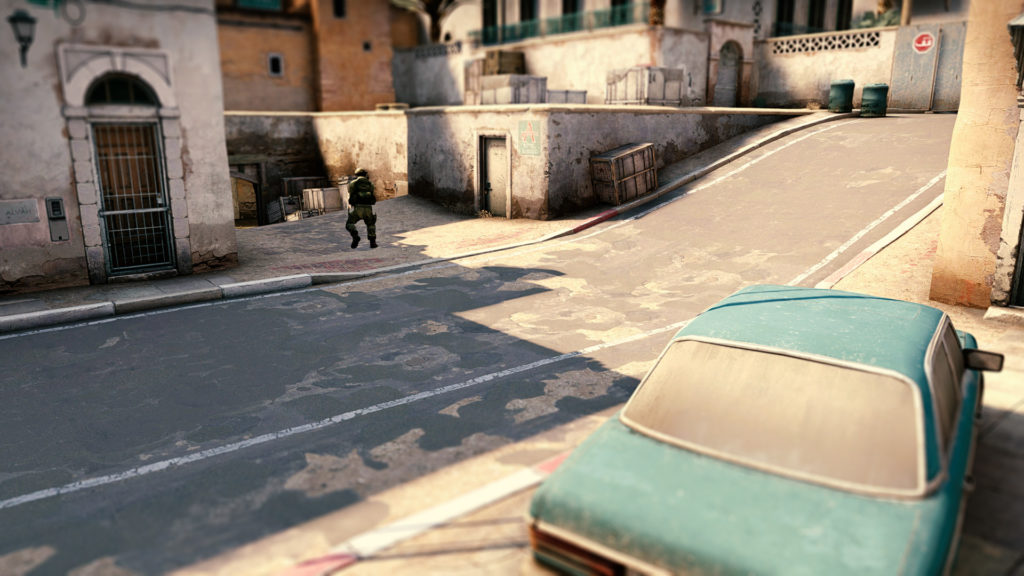However you assess it, it’s clear that Counter-Strike: Global Offensive continues to grow.
We recently saw the highest number of concurrent active players in-game ever and it’s clear that the professional game is gaining more and more traction. Perhaps too much.

There are now three main event organisers on the CS:GO scene: ESL, Blast and FaceIt. Others worth mentioning are Dreamhack, Games Clash and IEM.
It’s clear to see, it’s pretty overcrowded. If you compare it with traditional sports, you don’t have multiple ‘Premier Leagues’ in the UK or different MLBs in the States.
Ultimately, the audience want leagues and tournaments that include the very best talent all competing against each other.
That’s what FaceIt want to achieve with Flashpoint.
What is Faceit trying to do with Flashpoint in CS:GO?
In short, Flashpoint is a new, rival league operated by FaceIt to the long-standing ESL Pro League. It was previously referred to as “B Site”.
They plan on two seasons per year, just like ESL Pro League and have a CSPPA approved ranking system (Counter-Strike Professional Players Association) which is basically CS Pro Player Union.
The idea is that the tournament is built for longevity and sustainability with a franchise-esque model.
The Flashpoint teams
There are 12 teams in total that take part: ten founding teams buy-in for $2m and two teams that qualify.
The 10 Founding Teams:
So far, only six of Flashpoint’s reported ten franchised members have revealed their association with the league:
- Cloud 9
- Gen G
- Dignitas
- Mad Lions
- Owned by Overactive Media who also own
- the old Splyce team
- Montreal Rebellion OWL team
- Toronto Defiant OWL team
- Owned by Overactive Media who also own
- MIBR
- c0ntact Gaming
It’s worth noting that these teams will get a share of the league revenue.
The Two Qualifying teams:
The final two spots are decided by open online qualifiers then LAN playoffs.
They’re free to enter and doesn’t affect the amount of money you can win from the league. The only downside to these qualifying teams is they do not get a share of the league’s revenue.
Flashpoint Prize Pool
This is where things get juicy. There is a $2m prize pool but teams that fall outside of the Top 20 Rankings are subject to a fine of $100k.
This should incentivise teams to keep their best players or go out and recruit. The founding teams have large financial backing so have the means to go out and obtain big players/teams.
Fortunately for the audience, there is a high focus on content — both in terms of production and broadcast — with plenty of interviews, non-game team interaction (such as group-selection shows), shoulder content and so on.
“Everyone wants to be the ESPN of esports. Well, who says that ESPN is what’s right for gaming communities? We want to create an experience for the fans that’s authentic, it’s more raw, it’s personality-driven.”
Who is the talent on Flashpoint?
FaceIt have decided to hire some of the best on-air talents in the industry.
Interestingly, they have promised to pay them within one month rather than the three-month window that seems to be pretty standard in Counter Stike.
Here is the talent:
- Auguste “Semmler” Massonnat
- Old school commentator returns!
- Used to be part of the iconic Anders & Semmler casting duo before leaving CS for the Overwatch League in 2015
- Casted the CSGO play of the decade (Happy deagle ace vs TSM on inferno in 2015)
Congratulations to @Happy1, whose Deagle ace on Inferno at @DreamHack Open London 2015 won your vote for CS:GO play of the decade! https://t.co/bf51LxRCKh
— CS:GO (@CSGO) January 1, 2020
- Duncan “Thorin” Shields
- Creative Director of Flashpoint
- Dubbed “the esports historian”
- One of the original CS analysts
- Won multiple Journalist of the Year awards
- Christopher “MonteCristo” Mykles
- If Thorin went to private school, the result would be Monte Cristo
- Used to be an analyst for LCS (LoL) and OWL (Overwatch)
- Founder of Renegades esports team
- Coached CLG LoL team
- James “Yet to Frag” Bardolph
- Arguably the face of FaceIt
- Lover of in-game skins, stickers, and keyboards
- Casted the graffiti worthy double AWP no-scope on Cache by s1mple at ESL One Cologne 2016
- Daniel “DDK” Kapadia
- Quake enthusiast
- Casted the jumping double no-scope AWP kill & 4K by Coldzera at MLG Columbus
- Jason “Moses” O’Toole
- Analyst and commentator
- Now casts with Anders
- Casted 500IQ wall bang 3K and ace by Xyp9x at Blast Pro Series Copenhagen 2017
- Anders Blume
- The other half of perhaps the greatest casting duo of all time
- Considers as the voice of counter-strike by many
- OMG HIKO ARE YOU KIDDING ME?!
- Sean Gares
- Previously IGL of the second most successful iteration of Cloud 9
- Great hair
- Freya Spiers
- Interviewer/stage host
- Did this for FaceIt London Major too
- Came through a FaceIt competition on Twitter to be part of the broadcast talent and has continued to grow and improve from there
- Interviewer/stage host
Flashpoint League Format Details
Let’s jump into the details of this tournament:
Flashpoint splits up into two sections: the open qualifiers and the regular season itself.
The format video does cover a lot and might seem a little confusing if you’re watching it for the first time.
Above, we mentioned that teams can take part in the league by either being one of ten founding members or by taking part in the open qualifiers which have two available slots.
Here is how it works in more detail:
Flashpoint Open Qualifiers
The Open Qualifiers take place in European, North American and South American regions.
The top four teams from each European qualifier, the top two teams from each North American qualifier, and top two teams from each South American qualifier then compete in a regional closed qualifier to determine who goes through to the regular season.
- Open qualifiers complete
- Regional qualifier upcoming
Flashpoint Regular Season
Once all the 12 teams are confirmed, we move to the regular season.
During the full season, the aim is to earn as many points as possible in order to get the best seeding for the playoff bracket.
There are two phases and each phase consists of the 12 teams dividing into three groups of four teams each. Each group will play a double-elimination bracket in which every match is a best-of-three.

The conclusion of each phase will result in the teams in each group’s teams being ranked first through fourth.
The captain of each top three seeded teams will randomly select a letter (A, B, or C) that will assign each team to their next Group.
Beginning with Group A, the team captain will select one team currently unassigned to a group to become their first opponent at the start of Phase 1.
The captains of the remaining top-seeded teams will also select their opponents, starting with Group B and continuing to Group C.

The subsequent rounds of team selection commence with the captains of the teams most recently assigned to a group choosing an unassigned team to join their group until all twelve teams have been assigned.
The selection process always begins with the most recently assigned team into Group A, followed by Group B, and concluding with Group C.
Teams are always selected into the first available row in each group’s table, starting at the top and proceeding to the bottom.
To add to the complexity, there are swaps options too.
Once all twelve teams have been selected into groups A, B, and C, the final team selected into each group may make one swap. The team in Group A will swap first, followed by Group B, and concluding with Group C.
If a team with an option to swap is themselves swapped to another group, they maintain the ability to swap in their original swap order.
For example, if the team selected last in Group B is swapped to Group C, they still swap second and not third.
- 3 swap options:
- Swap any two teams between groups, subject to veto
- Swap the positions, and therefore first-round opponents, of any two teams in the same group, which cannot be vetoed
- Relinquish the option to swap
- Swap restrictions
- A team may not “undo” a previous swap, meaning that if two teams have already been swapped they may not return to their initial Group assignments from the Group selection. However, a team may be swapped multiple times as long as it does not also include a team with whom they have been swapped previously
- If a swap is vetoed, it may not be proposed again by any team
- If a team has had two swap attempts successfully vetoed, they must pass their opportunity to swap.
- Swap Vetoes
- Each first-place team from the previous Phase receives two Nay Cards and four Yay Cards to be used during each attempt to swap
- When a swap of teams between groups is proposed (swaps within a group cannot be vetoed), each team captain selects and holds either a Yay or Nay Card without revealing it to the audience or other teams
- The Host will prompt each captain to reveal their hidden Card, at which point the Host will take the revealed Card from the captain
- If two or more Nay Cards are revealed, the swap is vetoed. If two or more Yay Cards are revealed, the swap proceeds
- If a swap is vetoed, the team proposing the swap may attempt another swap
- If two swaps proposed by the same team are vetoed then the team must pass their opportunity to swap
- If a team has no remaining Nay Cards then they cannot vote to veto a swap and must submit a Yay Card instead
At the conclusion of each phase, teams earn Playoff Points based on their final standing within their Group.
Playoff Points are cumulative across the two Phases and determine which eight teams advance to the Playoffs and each team’s seeding within the Playoff bracket.

The amount of Playoff Points accrued per Phase is dependent on each team’s final Phase ranking
- 1st place: 75 points
- 2nd place: 50 points
- 3rd place: 30 points
- 4th place: 15 points
Declaring the winner of Flashpoint
The winner of Flashpoint Season 1 will be declared once they win the Grand Finals in the GSL double-elimination playoff bracket.
Once again, every game is best-of-three.
The easiest way to think about it is that teams need to get as many points as possible so they have the best chance in the playoffs as they will be seeded higher up.
You can follow all the latest matches on Flashpoint Twitter and Twitch as well as CS:GO Liquipedia always been a great resource too.
If you have any questions then make sure to head over to our Discord server or if you’re looking to get better at CS:GO you can also hire one of the GamersRdy CS:GO coaches to help you get better with a personal coaching session.
Hopefully, this guide gives you a good idea of how Flashpoint works!





